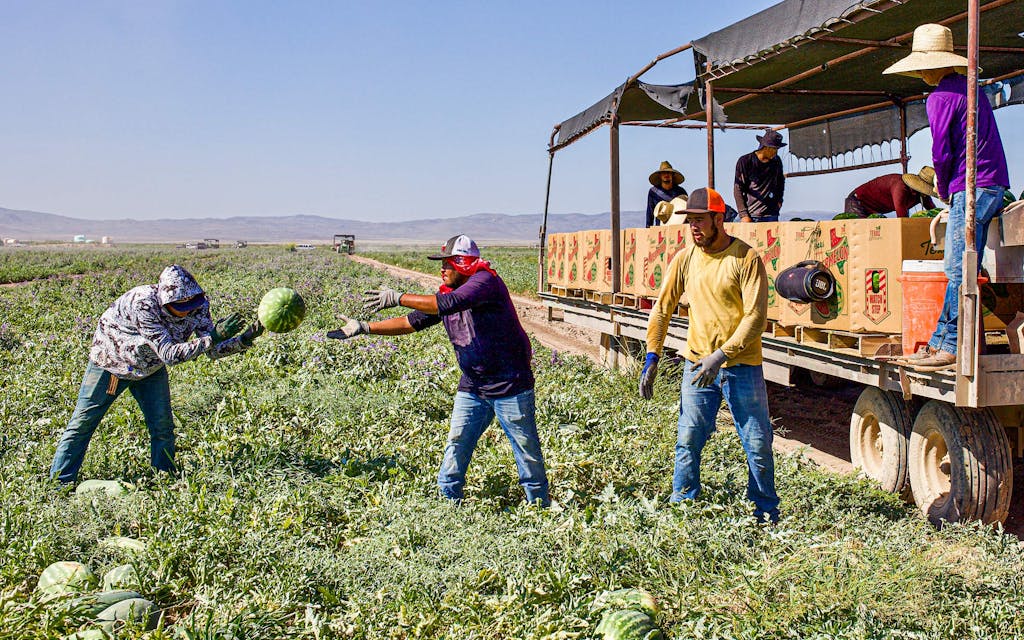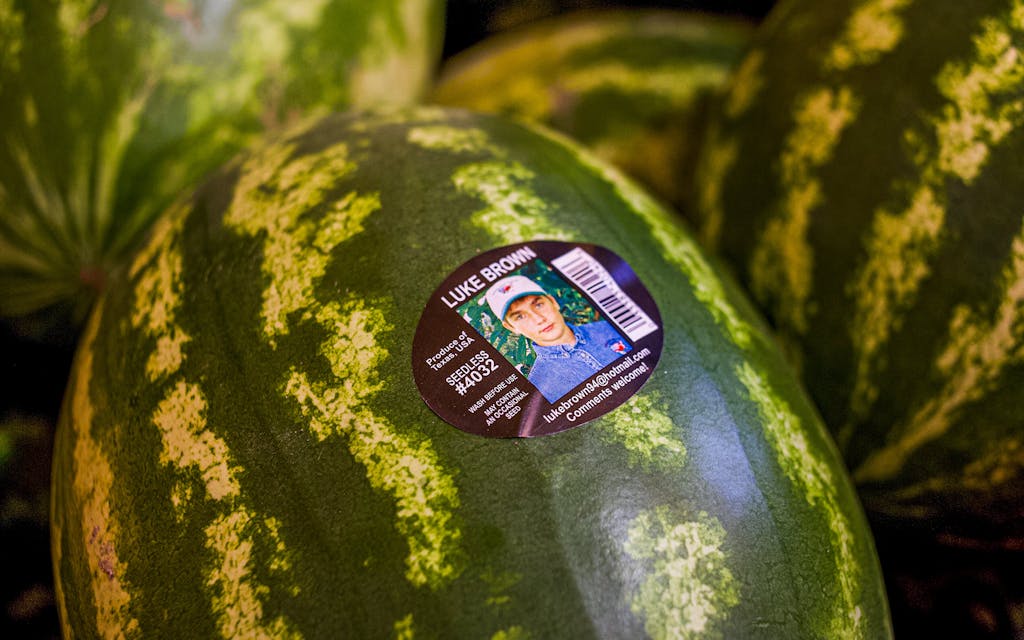The Watermelon King of Balmorhea
Luke Brown #LukeBrown

“Did you get that belt going?” Luke Brown asks over the purr of his truck’s engine. He’s looking out the window of his mobile office, a white Chevy Silverado, which is parked on a dusty dirt road in the middle of 240 acres of watermelon vines.
The farm’s harvest contractor, Kurt Denney, replies from the truck idling beside Brown’s. “It’s that plastic—it’s all balled up on ’round the rolls and then the little pulleys on the motor.”
A minuscule black belt, part of the machinery on one of the harvest trailers, has been malfunctioning. The men decide that not much can be done until Brown’s wife, Kendall, arrives from Fort Stockton with a replacement. She made the fifty-minute drive earlier that morning. “She said she got four belts,” Brown tells Denney. In a comforting East Texas drawl, he adds: “Surely something will work, then.”
Brown’s life as a watermelon farmer is all about managing details. Although he’s one of the smaller major growers in Texas, the 28-year-old owner of Luke Brown Farms, outside Balmorhea, has carved out a distinct niche in the state’s watermelon landscape. His melons are prized across Texas and as far away as New York for their intense sweetness and juicy red flesh. The fruits’ outsides are just as notable as their insides—each features an oval sticker with a photo of Brown at age 14, a Hotmail address, and the phrase “Comments welcome!” A fourth-generation watermelon farmer and the president of the Texas Watermelon Association, Brown has become a success story even as some growers have left the business. In the fickle world of watermelon farming, disaster is always only a few neglected details away.

 Workers load watermelons into the harvest and packing trailer.Photograph by Lea Konczal
Workers load watermelons into the harvest and packing trailer.Photograph by Lea Konczal
After leaving Denney, Brown turns down one of the narrow dirt roads that bisect the fields. He parks and strolls toward some field-workers, planting his cowboy boots carefully to avoid rattlesnakes that might lurk among the vines. He approaches three men in wide-brimmed straw hats. These are the cutters, the men who identify the ripe melons and sever them from their vines before they’re placed on the harvest trailer.
The men turn toward Brown. “Que pasó?” one says.
“Nada.” Brown asks about the men’s progress, seamlessly trading his English for Spanish.
“Necesita más sesentas,” he concludes—more sixties (sixty-count loads of small melons) are needed.
The men talk a little more, and no sooner has the conversation wrapped than Brown’s iPhone rings. The screen reads “Papa Ronnie”—although no longer a stakeholder in Luke Brown Farms, Brown’s grandfather is eager to learn how the harvest is going.
It was Ronnie Borders who came up with the idea to make Brown the face of the family brand. Ronnie’s father, Alton, was an East Texas watermelon farmer who died when Ronnie was twelve. Ronnie embraced his father’s trade, building a business in Brown’s hometown of Center. He bought cotton trailers (the same ones Brown uses today) that were made in the sixties and seventies and retrofitted them with brushing and sorting systems so workers could harvest, clean, and pack watermelons in the field, eliminating the need for a shed crew and reducing opportunities for bruising. Brown, the son of Ronnie’s daughter Beth, got his start in 2008 by posing for the sticker photo and answering emails. He soon began farming for his grandfather and his uncle Nowell Borders, who runs a large watermelon outfit in the Rio Grande Valley. After high school, Brown spent a year studying business administration at Howard Payne University, in Brownwood, before deciding to focus on watermelons full time. Ronnie suggested he do that in West Texas: the family owned a watermelon farm in Balmorhea. Ronnie and Brown ran the farm as partners until Brown eventually took over operations and later bought it in 2020.
As he’s aged, Brown has thought about updating the photo on the sticker or switching to a different email domain (“Everybody makes fun of it,” Kendall says of the Hotmail address). Maybe if he has kids who join the business, he’ll put one of their faces on the sticker. But by keeping the sticker and email the same, Brown is building brand recognition and expanding a digital archive that stretches back more than a decade.
“So, perhaps the first email I ever received would be that one right there,” he says, showing his phone screen. “And that was in 2008. ‘Hey, Luke, I’m Anna. I live in Leander, Texas, just twenty miles north of Austin, and I ate some of your watermelon; it was delicious. Keep up the good work.’ ” Today, thousands of emails arrive every summer. They’ve come from as far away as Canada (Brown sometimes ships there) and the UK (presumably from tourists who tried his melons in the States). Sometimes the email exchanges evolve beyond watermelons. In 2011, a husband and wife in Buffalo Gap sent Brown a praise-laden note. They ended up driving 285 miles to visit the farm and later swam alongside Brown at Balmorhea’s famous spring-fed pool. They still keep in touch, and Brown sometimes stays at their house when he’s traveling.
Then there was Jesse, the man in his seventies who contacted Brown six or seven years ago. “He was so glad that he could go to the store and pick up a Luke Brown watermelon, and it was good every time,” Brown says. “He would always email me.” One year, Brown was greeting customers beside his watermelon bin at an Austin H-E-B. “I didn’t even realize I was in the store that Jesse shopped in. And he said, ‘Luke?’ And just like that, we met for the first time in person.”

 This sticker featuring a photo of Brown at fourteen adorns every watermelon he sells.Photograph by Lea Konczal
This sticker featuring a photo of Brown at fourteen adorns every watermelon he sells.Photograph by Lea Konczal
As Brown watches a harvest trailer and its crew make their way across the field, another truck pulls up. The foreman, Alvaro Sosa, a cowboy-hatted, bespectacled man with a salt-and-pepper mustache, gets out to discuss the day’s operations. He’s the crew’s spiritual—and, in many cases, literal—patriarch. His son, Alvaro Jr., drives one of the tractors, and some of the trailer workers are his grandsons. His youngest daughter, Ariadna, a college student studying accounting in the Rio Grande Valley, is working in Brown’s office this summer to help him coordinate shipments. Many of the other employees are related too: the farm manager’s daughter does the stickering; her husband drives a forklift and helps with irrigation. This year’s harvest season stretches from June to October, and right now, in the busy part of the season, the workers are laboring from around 5:30 a.m. to 2 p.m. each day. “This week, we’ve been trying to buy lunches and buy dinners . . . just something so they don’t have to worry about cooking,” Brown says. “I don’t know how you can give enough praise for the job that they’re doing. It’s impossible without them.”
Impossible, too, without Brown’s wife. Kendall pulls up to the farm in the late morning with four replacement belts for the trailer. “I just run parts and stuff when they need me to,” she shrugs. Brown puts it differently: “She’s just major support to me. Anything and everything, she can get it done.”
When Brown first met Kendall, at the National Watermelon Convention in Georgia in 2014, she was the Texas Watermelon Queen competing for the national title. He was a farmhand.
“She had on kind of a gold sequined dress,” he recalls. “I had just gotten there—hadn’t been there twenty minutes. And we were standing kind of in the lobby area, where they had some booths and stuff set up, different vendors. And we were talking, and . . . I liked her. And I wasn’t sure if she liked me.”
When the weekend ended, Kendall went back to Texas A&M, where she was studying agricultural economics. But she returned that summer to her family in the Rio Grande Valley, where Brown was working for his uncle. His aunt, who was friends with Kendall’s mom, learned that Kendall was back and asked Brown if he’d like to see her.
“Heck, yeah, I’d like to see her,” Brown recalls thinking. “I got in touch with her, and we just really hit it off from there.” They married in 2016.
Brown occasionally cuts open a watermelon to check for ripeness. Photograph by Lea Konczal Sorting and stickering watermelons. Photograph by Lea Konczal
Brown harvests roughly a million watermelons a year, farmed on both his 240 acres and a partner’s 100. (Brown’s farm has a total of 600-plus acres, for rotating the watermelon fields to keep the soil in good shape.) Although most Luke Brown melons end up in Kroger and H-E-B stores in Texas, some go to WinCo Foods, an Idaho-based chain. Another small but important chunk of product goes to smaller, upmarket New York retailers. “I’m able to hedge myself with customers in New York who really appreciate quality and pay for quality,” Brown says. “Their market’s a little different than the chain-store Texas market.”
“I have one customer I’m selling [to] now,” Brown adds, “he’ll call and say”—Brown mimics a New York accent—“ ‘Aw, they’re cryin’ up here, Luke. They want your melons.’ ”
Kendall laughs. “I think they probably enjoy listening to his accent just as much, you know.”
“I think it’s mutual—yeah. I’m playing the country farmer part, and they’re playing the part, I mean . . .” He trails off, perhaps imagining a fast-talking, streetwise watermelon boss. Then he adds, chuckling: “Neither one of us are playing a part; that’s what we are.”
On a recent Wednesday, Brown was at a restaurant in town when a family from the UK walked in. Brown learned they were on a road trip from Disneyland, in California, to Disney World, in Florida. “I had a watermelon in the truck,” he says. “I gave it to ’em, and told ’em that if they were in Texas, they needed a Texas watermelon. And then as we were leaving, they were all outside taking pictures with it.” The moral: “If you give somebody a good watermelon, it can be one of the very best presents they can receive.”
With such zeal for Citrullus lanatus, it’s easy to see why Brown was elected president of the Texas Watermelon Association in 2021. A chapter of the National Watermelon Association, the TWA promotes Texas-grown melons and crowns the annual state watermelon queen, who travels to encourage production and consumption of the red-and-green fruit. Texas is one of the top four watermelon-producing states in America. But on a farm-by-farm basis, production is often too fickle to be lucrative. Although this year has been good for Brown—the farm’s dependable water wells and efficient drip-irrigation system have mitigated effects of the ongoing drought—“the last time we had a market like this was seven years ago,” Brown says. Some years have brought hailstorms; others, lower production. In 2019 and 2021, production was great but the market was cheap.
“A lot of watermelon farmers have quit or gone back to conventional row crops and gotten out of the specialty crops. They’re tired of not getting paid enough and losing money,” Brown says. “It’s a profession that you must enjoy to do it.”
By 1 p.m., the field-workers have taken a break for lunch, so Brown ends his inspection tour. He and Kendall drive back from the fields to the warehouse area. It turns out the malfunctioning belt is attached to the trailer and can’t simply be replaced. But Brown isn’t fazed—at least now he has four spares.
“I guess I’m an optimist,” he reflects. “You have to be a major optimist to be a farmer.”